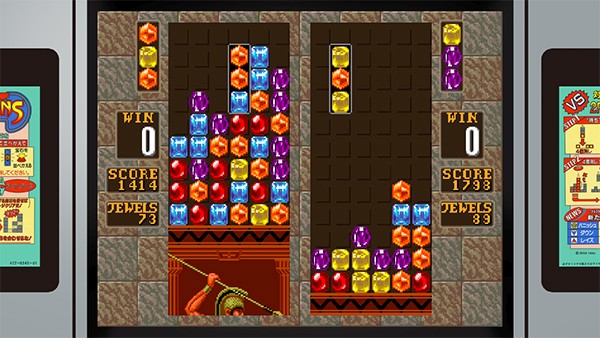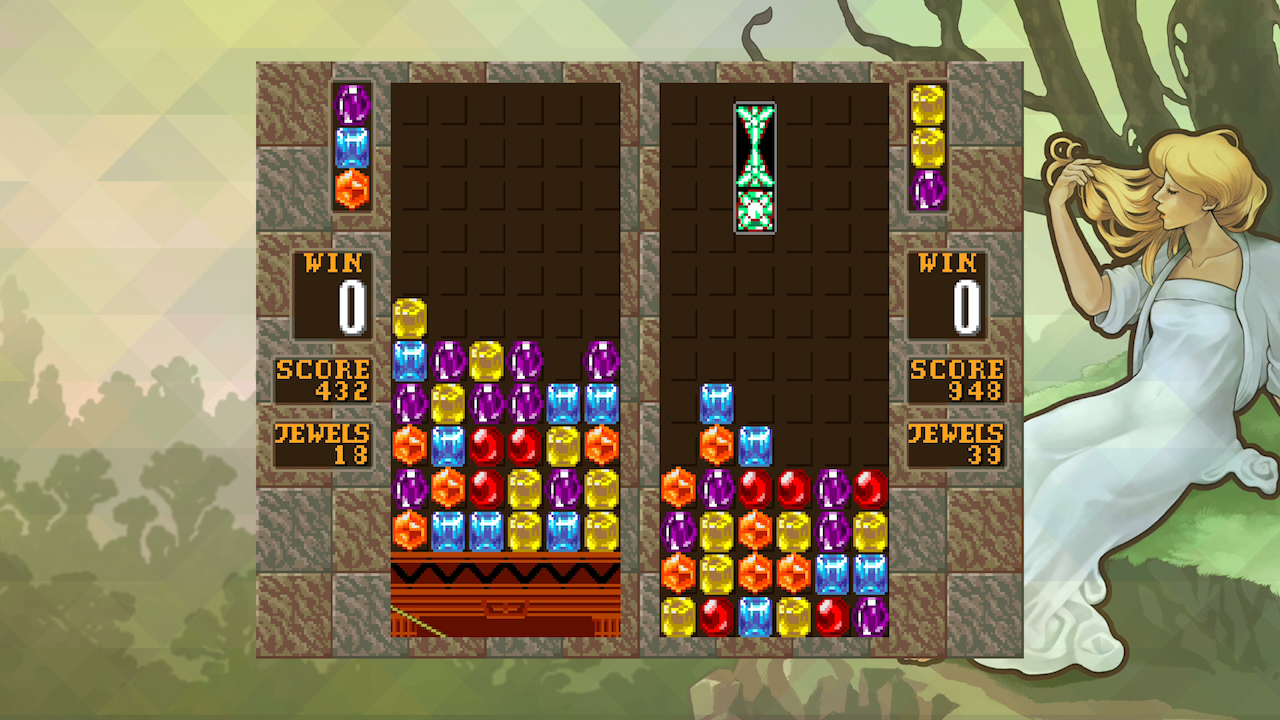Search
[{{{type}}}] {{{reason}}}
{{/data.error.root_cause}}{{{_source.title}}} {{#_source.showPrice}} {{{_source.displayPrice}}} {{/_source.showPrice}}
{{#_source.showLink}} {{/_source.showLink}} {{#_source.showDate}}{{{_source.displayDate}}}
{{/_source.showDate}}{{{_source.description}}}
{{#_source.additionalInfo}}{{#_source.additionalFields}} {{#title}} {{{label}}}: {{{title}}} {{/title}} {{/_source.additionalFields}}
{{/_source.additionalInfo}}- Details
- Category: Switch
- By Sam George
- Hits: 2382
Sega Ages: Columns II: A Voyage Through Time (Switch)

Sega Ages: Columns II: A Voyage Through Time
Developed by: M2
Published by: Sega
Release date: October 17, 2019
Available on: Nintendo Switch
Genre: Puzzle
Number of players: Single player, online and local competitive multiplayer
ESRB Rating: E
Price: $7.99
Thank you, Sega, for sending us a review key!
I can’t prove that Columns was intended to challenge Tetris. I can’t prove that Columns I, created in 1989, was inspired by Tetris’s release onto the NES the prior year. What I can say is that the tile-falling, stack-building gameplay of Columns II: A Voyage Through Time made me think of Tetris constantly. Columns is distinctly its own game, closer to match-3 puzzlers or Puyo Puyo than the venerable block stacking giant that is Tetris. To that extent, it is an interesting experience. If you know of and are already a fan of Columns, this edition is great, and I highly recommend it. If you are interested in the direction tile-falling gameplay could have gone, then it is also worth a look. Just keep in mind that more of you know about Tetris than know about Columns, and there’s probably a reason for that.
Columns II adds a competitive multiplayer component to Columns I, which is included with this game. The sequel also adds themed sprites and music vaguely selected from jungles, deserts, and factories of the past and future (the titular “Voyage Through Time”). Most importantly, perhaps, in Columns II the screens are not empty by default. Every level starts with flashing gems that must be cleared to move to the next. In this Sega Ages edition, every five levels unlocks a sprite of an anime-style girl from another game to view on the pause menu. If that feels odd to read, I assure you that it was odd to play a game in which the most obvious extrinsic rewards are pictures of young and slightly underdressed cartoon girls.

Strong Points: Good presentation and options; responsive controls; includes Columns I as well; quick to restart after a game over
Weak Points: Hard to the point of frustration at times; often reliant on luck
Moral Warnings: Some scantily-clad anime-style characters
Columns is played in a grid with falling multicolored pieces. Each piece is a vertical stack of three colors styled as gems, stones, or something similar. The colors can be cycled (bottom to top, middle to bottom, and top to middle) until the piece reaches the bottom. When three or more of the same color match up, they disappear and the whole stack drops to fill the gaps. If the stack reaches to the top of the grid, the game is over. The strategic implication, pointed out by the in-game manual, is that setting up diagonal lines of colors is more effective than vertical or horizontal since it moves pieces around in a wider area. The practical downside is that the game depends on randomness. There is not a lot to do with colors that don’t match any of the exposed pieces already in the stack, and three-high pieces fill up the play area quickly. I will be the first to tell you that I am not exceptionally good at Columns, and that knowledge does not shake the feeling that most levels were cleared by my luck more than my skill. In my defense, the in-game manual acknowledges that Columns is hard and suggests starting on Easy mode.
After a game over, it is easy to hop back into a round. Columns II can certainly be compelling. That is not necessarily the same as fun, and since the piece distribution felt so random, I often did not feel like going one more round would develop more skill. Skill is involved; one can get better at Columns. But there is only so much to do with undesired blocks, and Columns is unforgiving of individual poor placements. It is hard to start from scratch half-way up the grid. Some levels start with the grid almost completely full. Skill will enable you to survive longer under those conditions, but without helpful colors in the randomly-generated pieces, it is hard to make progress downward through the stack.

Higher is better
(10/10 is perfect)
Game Score - 74%
Gameplay - 13/20
Graphics - 8/10
Sound - 7/10
Stability - 5/5
Controls - 5/5
Morality Score - 96%
Violence - 10/10
Language - 10/10
Sexual Content - 8/10
Occult/Supernatural - 10/10
Cultural/Moral/Ethical - 10/10
Columns II is enough of a classic to receive this rerelease. As a retro game package, this Switch downloadable should be commended. It includes Columns I, keeps the original resolutions, uses original music and sprites, and even includes an old school high score table where the player gets three letters to put next to their score. It also includes an online competitive mode, though I have been unable to find an opponent. Local competitive multiplayer works well; the simple controls are perfect for the Nintendo Switch’s Joy-Cons. The game runs well and the controls are tight. With no moral concerns aside from the anime banner girls, if one enjoys the game, this is a great way to play it.
I could never remove that other block-falling game from my head, but perhaps that says more about me than it does about Columns II. Like I said, it is a hard game. The presentation is great and the gameplay is as solid as it ever was. Columns II is not to my taste, but it may be to yours.








